Ancient Egyptians believed that a man is composed of different elements some of which were immortal. Egyptians saw death as termination of life, as an obstacle over which a man must pass in order to reach eternity. In the moment of death, the body leaves an immortal element, Ba. However, no matter what form of existence was given, it represented a permanent connection between this world and the body in the grave. So man was still addicted to food and other gifts that were in the grave for his continuous life in the next world.
Mummification
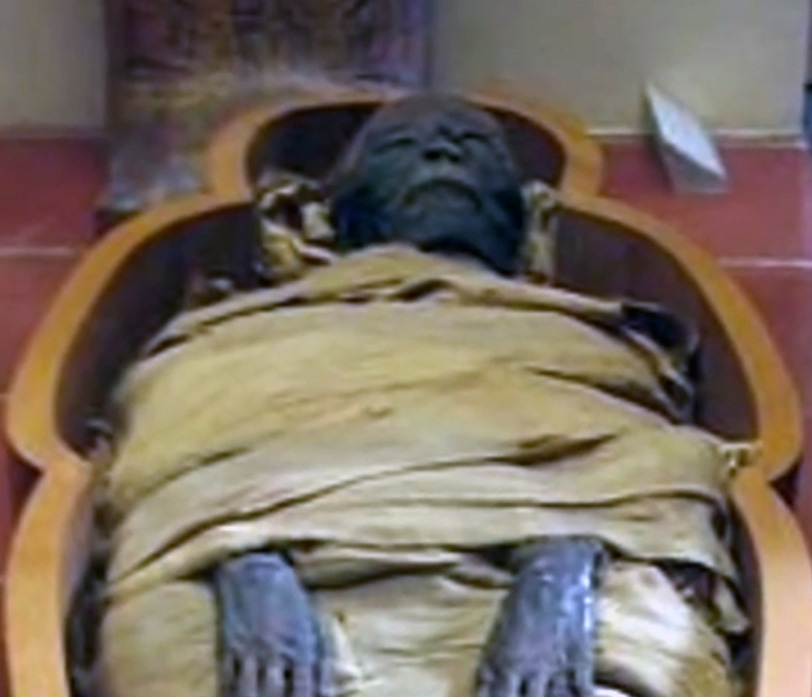


Was a process in which the body of deceased was preserved. Goal of this process is to release those elements of the souls that will survive death of the body. The womb is disposed in special containers, canopic jars, and after that, the body is washed with palm wine, soaked with salt, bitumen and essential oils. Then embalmers filled the body with aromatic substances, and soaked it in natron for a long period. Finally, embalmers firmly wrapped up the body in linen bandages, which were covered with the resin or alcoholic substances. When the mummy is completely wrapped up, once again embalmers fume the mummy with frankincense while the priests recite great final prayer: “To you Osiris, comes frankincense, that came from Horus,chrism which came from Ra,natron which came from Nekhbet…”
After death, the pharaoh (which is considered part of the divine) again unite with his father Ra, God of the sun. Pyramid, the place of his burial, can be considered as a ramp or some other kind of king’s approach to the sky.
During Egyptian history of the early dynasties, wealthy people were buried in visually distinctive stepped buildings known as mastaba.
Reasons for building Pyramids
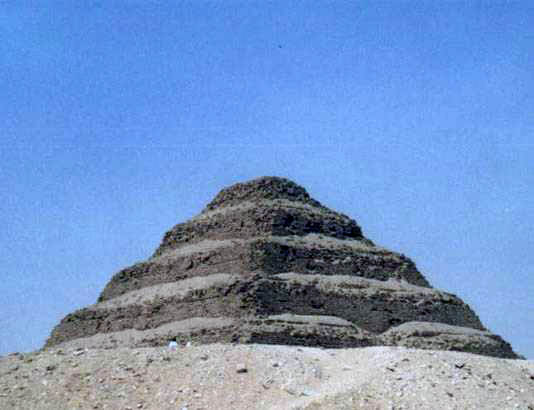


The first historically documented pyramid is attributed to an architect , who designed the tomb. Archaeologists believed that pyramid was built for Pharaoh Djoser and it was designed as a series of mastaba, one on top of the other. Therefore, in that way it would create a structure that has a number of steps that tapered toward the top. The result was Djoser pyramid – which is designed to serve as a huge staircase, which a soul of the deceased pharaoh will use in order to ascend to heaven. The importance of Imhotep’s achievements was so great that later Egyptians declared him as God. Each pyramid had its name, later, complexes that were surrounding the main pyramid, were given special names. Most pyramids later, local people gave Arabic names. Many years after the end of the construction period of the pyramids in Egypt, started a construction fever in the area of today’s Sudan, at that time kings of Napata ruled large parts of Egypt. Although Napata’s reign was brief and ended in 661 BC, Egyptian influence has left an indelible mark, therefore during the last Sudanese kingdom Meroitic flourished construction of Nubian pyramids.
Although it is generally accepted that pyramids are tombstones, there is a permanent disagreement on certain theological principles that inspired their construction. One theory that is becoming more and more accepted is that the pyramids were designed as a “means of resurrection”. Egyptians believed that the dark part of the night sky around which the stars circle is a physical entrance to heaven, and that one of the axis that runs from the main burial chamber through the top of the Great Pyramid is directly focused at the center of this part of the sky. This suggests that the pyramid could be designed as a means to magically launch the deceased pharaoh soul directly into the home of the gods. All Egyptian pyramids were built, without exception, on the west bank of the Nile. This area is a place of the sunset that is associated with the Empire of the dead in Egyptian mythology. It is believed that the techniques that were used to build the Egyptian pyramids were originally developed through a number of trials and that they learned from mistakes. Egyptians later learnt from those mistakes and adapted with economic experience and human resources in over thousand-year-long period of building the pyramids. Discovered tombs of workers showed how pyramids were built and how important workers have been: workers on the pyramids were paid artists, not slaves, and they had their own city in Giza.
Pyramid of Cheops or the of Giza
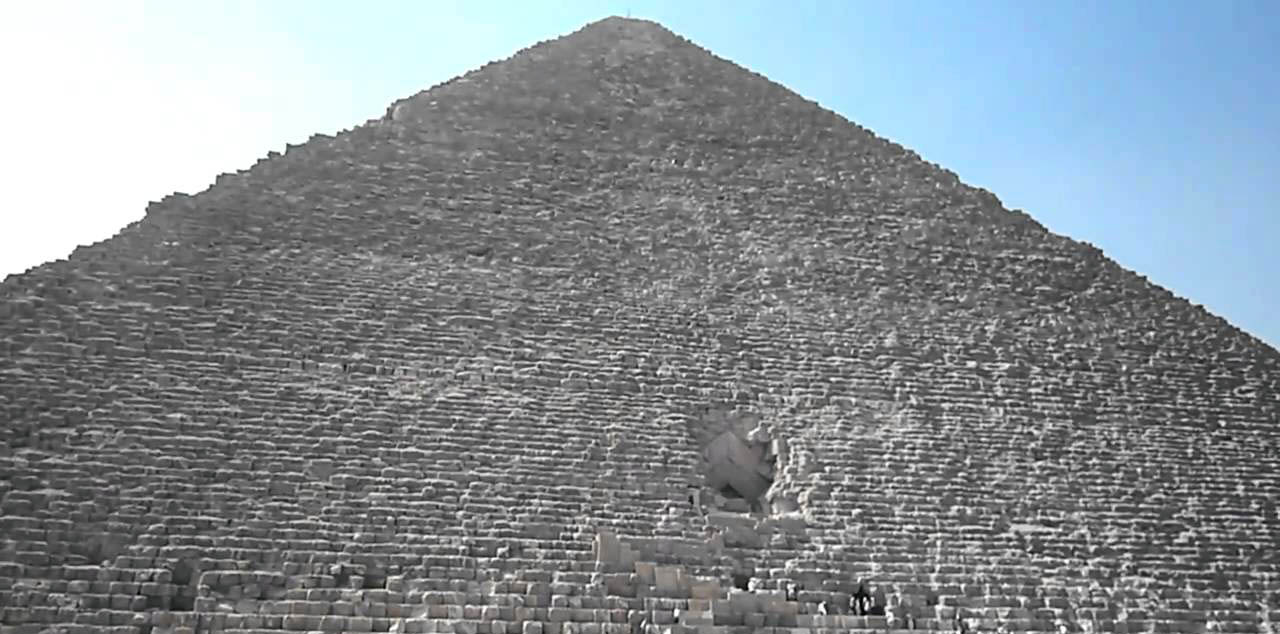


Pyramid of Cheops (Khufu) or the Great Pyramid of Giza is the tomb of the Pharaoh Cheops at Giza. It was built around 2560 BC by orders of Pharaoh Cheops, Sneferu’s son and heir. It is believed that about 100 000 people built the Great Pyramid for 20 years. Each stone is 2 m high, while some stones are as long as 5 m. The pyramid was built from blocks of limestone and granite, which were excavated on the left bank of the Nile and transported by boats down the river. This could only be done in the spring, when the Nile flooded the area, and that is the reason why it took them 20 years and around 500 000 river transports in order to bring the required amount of stone. In order to transport stones, a group of people would drag blocks, each weighing 2 tons, on the sleigh along the way. Then these blocks were neatly lined up, while another group of people would dragged them to the location of the pyramid. When it was built, the pyramid was 145.75 m high, but over the years, the pyramid was reduced for around 10 m. The area of the pyramid was covered in a very smooth, almost unnoticeable limestone. The pyramid is consisted of about 2.3 million stone blocks. On the pyramid’s north side there is an entrance. The interior of the pyramid consists of three chambers connected by numerous corridors. At the heart of the pyramid is the King’s Chamber, where lies the sarcophagus made of red granite. An angle side in relation on the base is 51° and 51’ and each side is carefully oriented towards one of the four corners of the world. The horizontal cross section of the structure in any one part of the pyramid is square; the side length of the base is 229 meters. Officials, who served Cheops, built its own tombs around his pyramid. Cheops himself wanted to bury his mother’s body Hetepheres beside him. In 1954, in a pit near the Great Pyramid was discovered an intact boat long about 48 m and about 5 feet wide. After 16 years of working, the boat again assembled and exhibited in a modern building near the sites.
Pyramid of Khafre
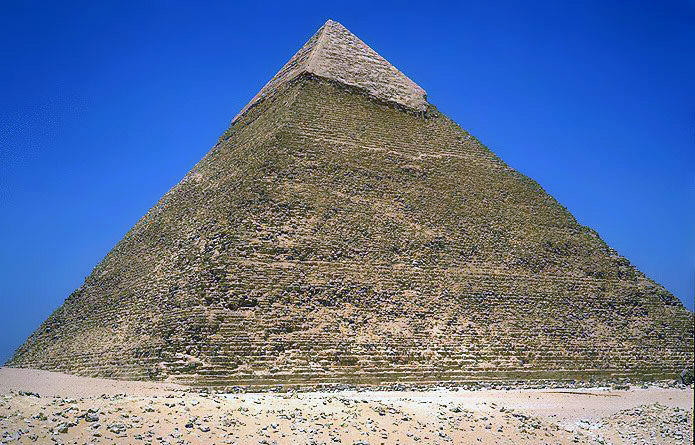


Is smaller than pyramid of his father Cheops (Khufu), but his pyramid was found in better condition. The original height of the Pyramid was 143.5 meters. The current height is 136.4 m. The pyramid was built during the Fourth dynasty. It was made of red granite blocks, weighing about several tons and its red color is in the contrast with white alabaster floors. The remains of its original coating are still present at the top of the structure. People say that pyramid was so sparkling that it was visible from the Masada in Israel. In time, the coating from the pyramid was taken off and it was used in the construction in Cairo. The tombs were looted, as most of them in Egypt. In the pyramid was found a statue of Khafre, which today is in the Cairo museum.
Pyramid of Menkaure
Pyramid of Menkaure is much smaller than the previous two pyramids. The height of the pyramid is 65 meters. Some parts of her mortuary temple remained intact. Pyramid of Menkaure in its interior contained a special room intended for the burial of a royal family member, or even the King himself. It was covered with granite plates of very high quality. The Menkaure mortuary complex was decorated with lots of statues and the most famous one is the so-called Menkaure triad. Menkaure triad shows the King between goddess Hathor and the personification of Egypt.
Red Pyramid
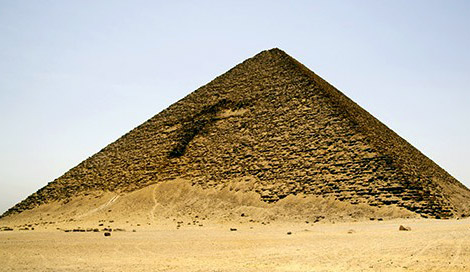


Pharaoh Sneferu ordered the construction of Red Pyramid after workers already built him, Bent Pyramid, which was a big mistake because it did not turn out perfect.
Red Pyramid is also known as the North or Bat, and it is the third largest pyramid in Egypt. At a time when it was completed a pyramid was the tallest structure. Its height is 104 meters, the side bases are 220 meters, and slope walls are 45°. For the base and the outer lining of the pyramid, workers used limestone from the Main Egyptian quarry Bison. Workers formed blocks of pink limestone. Red Pyramid has entrance on the north side about 28 m above the ground. After the entrance, there are two cambers in the same proportion.
